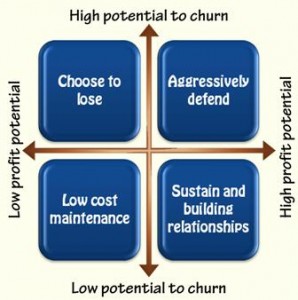 Customer churn in the services industry is still a growing issue, primarily because many consumers have little or no allegiance to a particular service provider.
Customer churn in the services industry is still a growing issue, primarily because many consumers have little or no allegiance to a particular service provider.
So, how do we solve this? The answer is knowledge: know your customers and know your prospects. As retailers are the customer-facing end of the sales cycle, much of the responsibility for producing customer loyalty has to lie with them.
I know many companies who collect vast amounts of data for ensuring risk management procedures. However, this information can be converted into a powerful tool to reduce churn by helping to answer three basic questions:
- How do I sign up profitable customers?
- How can I enhance loyalty with my most profitable customers?
- How do I handle my existing customer base?
Studies indicate that a 5 percent improvement in customer retention can increase profits by 85 percent. This highlights the supreme importance of encouraging customer loyalty.
The Goldmine = Customer Database
The customer database is a central resource which should house both current and historical information about a customer’s entire product holding with the company, which can be enhanced with geodemographic and personal data from an external information provider.
The database must also be capable of supporting detailed analysis and questioning and should enable the implementation of customer management strategies, such as outputting mailing lists and capturing the results of campaigns.
There is a vast amount of information available at household level on individuals. The electoral roll provides details of who lives at virtually every address. Normally this is updated annually; this enables household type, family units and length of occupancy to be identified. You can improve this further with dates of birth, directorships, credit performance, age and income estimates, etc. The most detailed information, collected via lifestyle questionnaires, includes newspaper readership, car ownership and holiday preferences.
Common characteristics amongst customers will provide the basis for different customer segments to be identified. This then enables profitability, cross-sell, churn and response models to be developed.
Once you know which customers are the most profitable and how likely you are to retain different groups of customers, developing customer management strategies becomes much more effective. An on-going relationship with customers can be built and those who show the greatest likelihood for upgrades because of their geodemographic profile, or who present the greater usage, can be identified.
Tailored Strategies for Customer Churn Management
For the segment with the highest potential to churn and a low profit potential, the strategy is to `choose to lose’ – or not work too hard to keep. The return from investing resource in attracting and retaining these customers is likely to be minimal: 20 percent of customers create 80 percent of losses (just as 20 percent of customers create 80 percent of the profit).
For those with a high potential to chum but also a high profit potential, the strategy should be to aggressively defend and build existing customer relationships. This could include product enhancements or special promotional offers.
For customers with a low potential to chum and a high profit potential, the strategy is not only to sustain existing relationships, but also target building new relationships. As well as special promotional offers, these customers could be offered enhanced service levels.
Customers who have both a low potential to chum and low profit potential can be farmed through a low cost maintenance program. This could mean following cost-effective contact strategies and ensuring pricing provides a return.
The above examples give some idea of the power of a properly managed customer database, but it is a power which is only now beginning to be fully realised in services industry. I believe that customer churn adversely affects companies because they stand to lose a great deal of price premium, decreasing profit levels and a possible loss of referrals from continuing service customers. In a highly competitive and mature services market, a defensive marketing strategy should become more important. Yes, instead of attempting to entice new customers or lure subscribers away from competitors, defensive marketing should be deployed with the purpose of reducing customer churn and brand switching.
Chintan is the Founder and Editor of Loyalty & Customers.






Nice article, Chintan. Your graphic is great!
Could you elaborate just a bit on determining “how likely you are to retain different groups of customers?” How can we know who is most likely to jump ship?